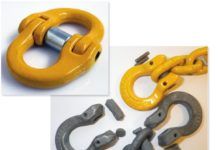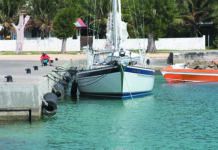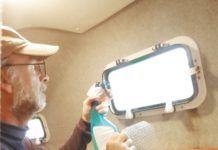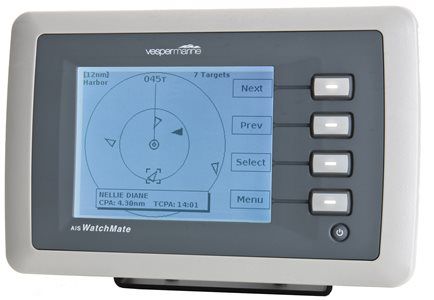AIS (automatic identification system) transponders put out a signal that describes your boat and what it is doing to other ships. It also receives the same information from any other ship within range. Commercial ships are now required by most flag countries to carry a transceiver—for big ships it is a class A—so most large vessels will show up as well as a good proportion of smaller ones.
The picture above shows the general screen with any local vessels displayed as triangles. Any vessel which will come within a preset distance becomes solid black and sounds an alarm—I usually set mine between one and five miles depending on how busy the area is. You can then scroll through the targets and for each one you get the information shown on the left. The important ones are its bearing, course, speed and closest approach.

In this example, Pacific Pearl is currently 3.53 nm away on a bearing of 098 M. Her heading is 307 T and COG is 310 T. If neither of you take any action, her closest approach will be 0.28 nm in 15 minutes. Since she is a full-size tanker, that’s too close for me, but since we are still well over two miles away, I am free to change course to increase that distance. When I do, she will see my course change on her AIS screen and will know exactly what I am doing.
In addition to the built-in screen, you can also link these units to a computer screen or chart-plotter, which will show ships’ positions on your chart.
Unfortunately, this unit was discontinued when Garmin took over Vesper Marine—they now only make a black box unit—but if you hunt around there are still some available. There do seem to be similar units available from other major marine electronics manufacturers with similar specifications.
AIS ESSENTIAL FOR PASSAGE-MAKING ACROSS BUSY SHIPPING LANES
The Vesper Marine WatchMate 850 was my choice for a class B transponder, which I installed for a passage from Aruba to the Panama Canal.
At the time I bought this unit, there were only a few on the market and the Vesper unit was more affordable than most of the other options. I also wanted a standalone unit with its own screen. There were others designed to connect to a chart plotter but I use a laptop and don’t always want it running when at sea. As a standalone unit, the power consumption was very low, about 2 ah/day.
The approaches to the Panama Canal are some of the busiest commercial sea lanes in the world so I thought now is the time to fit a transponder. The result was way better than I ever imagined. I expected it to be a good supplement to radar at night or in poor visibility, but the first surprise was its range. Even though the aerial was only about 10 ft. above sea level, it was reliably seeing contacts at about 50 miles. This is because the ships’ aerials are way up high so line of sight between the aerials is way over the visible horizon.
The second surprise was when watching large overtaking ships change course at about 16 miles astern. Each ship would alter course by a few degrees to ensure they passed five miles on either side of me. Since fitting the transponder, I have not had a close quarters encounter with a commercial ship on passage. I think this is a game changer in safety, similar to the arrival of GPS, and would now put it on my list of essential equipment for any boat anticipating coast or long-distance passage making.
AIS/DSC/GPS-EQUIPPED HANDHELD RADIOS

The second, and equally good purchase was a pair of AIS/GPS-equipped handheld radios. The unit I have is the Icom M91D and was DSC (digital selective calling) only, again the model is no longer available, but the current model is the M94D, which adds full AIS as well as DSC. All my radio equipment is Icom and I have found them to be excellent performers and very reliable. Before I switched to Icom, I had used a number of cheaper makes but found the transmission and reception was less clear, shorter range and less reliable. I would now only fit Icom or similar quality gear.
KEY ELECTRONICS FOR MOB SAFETY
This use of AIS/DSC is, in my view the ultimate MOB setup. The key to this is that you can place each radio MSI number into the other unit or a fixed-mount, DSC-equipped VHF. When I set this up, Icom did a fixed-mount VHF radio with a separate DSC unit, the M501. As with all things marine electronic this model has now been replaced and the current M501 is a single package and adds an AIS receiver. There is also a M510E EVO, which only includes DSC, again in a single package
The great thing about the DSC system is that you can “ping” another radio using its MSI number and it returns its GPS coordinates via the DSC capability, as long as it is turned on. The user does not have to do anything so it will find the person even if they are unconscious. You can then sail back very close to their position.
The person in the water can also hail the VHF to coordinate their rescue, if they are able. It is much easier for someone in the water to see an approaching yacht and call saying, “I am about 500 m off your port bow,” than it is for anyone on deck to see a person in the water. If the person in the water is able, they also have the option to press the “big red button” and send a general distress call via DSC.
Adding AIS into the mix is even better. This means that if the casualty activates the AIS emergency button any other boats in the area will receive an emergency alert which will show on their AIS screen marked as an MOB rather than just sending a GPS position as DSC does. With the emergency alert activated, the radio periodically transmits its GPS position automatically to update the system.
I now ask any crew who will be alone on deck to attach and turn on a radio at night or in any other conditions where it is prudent to wear a lifejacket. It seems the ideal solution for short-handed crew, particularly a couple where one person will be on deck while the other is busy below or sleeping.






































I will second the ravings about the Vesper Marine Watchmate 850. I purchased mine in 2014 and have nothing but praise for it. I also purchase the Vesper Marine SP160 VHF Splitter at the same time and use my masthead antenna…never had a problem with either of them. It performed perfectly during my roundtrip voyage to Hawaii in 2016 from Washington State and was especially helpful when hove-to about 150nm off the coast of Washington during a gale monitoring commercial traffic in/out of the Strait of Juan de Fuca. I have it connected to my laptop and it provides both GPS and traffic information. It’s a keeper.
I also had a Vesper Watchmate 850 on my Bristol 41.1 and really liked everything about the unit. Unfortunately it failed to powerup at the beginning of last season and I learned unfortunately that Garmin had purchased Vesper and discontinued this great standalone AIS unit (I presume to remove a product competing with Garmin products). The only similar (but nowhere near equal) replacement standalone AIS unit I found was the ICOM MA510. I have found the ICOM unit to be far less user friendly than the Watchmate 850 which I miss dearly.